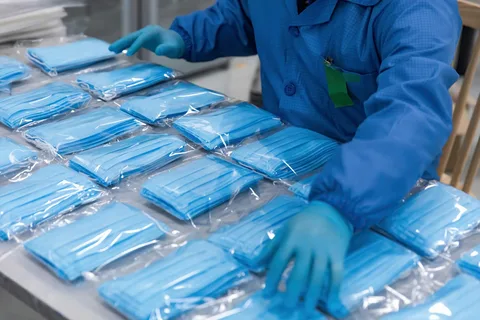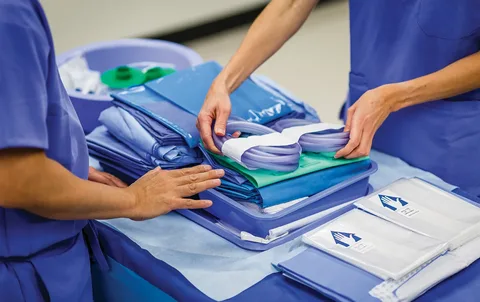In the ever-evolving healthcare landscape, ensuring safety and protection is paramount. The role of Medical PPE Supplies has become increasingly critical in safeguarding both patients and healthcare professionals. With rising concerns about infections and disease transmission, comprehensive knowledge about essential protective equipment is vital for every healthcare facility. This guide delves into the necessary items that form the backbone of infection control protocols, empowering facilities to make informed choices that enhance their preparedness and response strategies.
Essential PPE Supplies: What Every Healthcare Facility Needs to Know
PPE supplies are crucial for maintaining a safe healthcare environment. These supplies protect against the transmission of infectious agents, ensuring the safety of both patients and staff members. Proper selection, usage, and disposal of these items can significantly reduce infection rates.
Healthcare facilities must prioritise high-quality masks to provide adequate respiratory protection. Additionally, gowns and aprons are essential for minimising exposure during procedures that may generate splashes or droplets.
Eye protection is equally essential in a clinical setting. Face shields and goggles help shield healthcare workers from potential hazards while allowing them to maintain visibility during critical tasks. Understanding these essentials equips facilities to implement effective infection control measures efficiently.
Masks
Masks are a crucial component of PPE supplies in healthcare settings. They serve as a barrier to preventing the transmission of pathogens and protecting staff and patients during interactions. Various types of masks, such as surgical masks and N95 respirators, offer different levels of filtration efficiency.
Surgical masks are designed for single use and protect against large droplets and splashes. In contrast, N95 respirators filter out at least 95% of airborne particles, making them essential in high-risk environments where aerosol-generating procedures occur.
Healthcare facilities should ensure proper fit testing for N95s to guarantee optimal protection. Regular training on mask usage is also vital for staff members’ compliance with safety protocols.
Aprons, Gowns & Head Covers
Aprons, gowns, and head covers are fundamental components of PPE supplies. They serve as barriers to prevent contamination during various clinical procedures and protect healthcare workers from exposure to pathogens and bodily fluids.
Medical gowns should be fluid-resistant and appropriately sized for the wearer. Choosing the suitable material enhances comfort while ensuring maximum protection against infectious agents.
Head covers also play a crucial role in maintaining hygiene within healthcare settings. They help limit hair contamination and reduce the risk of transferring pathogens from the hair to patients or sterile environments. Proper use of these items is essential in safeguarding staff and patients.
Face Visors & Eye Shields
Face visors and eye shields serve as crucial components of PPE supplies. They provide additional protection against respiratory droplets, splashes, and potential contaminants. Their transparent design allows for clear visibility while safeguarding the facial area.
These protective gear options are essential in settings where close contact with patients is routine. Healthcare workers benefit from face visors that can be quickly disinfected after each use. Eye shields offer a comfortable fit and can accommodate prescription eyewear underneath.
In addition to personal safety, these items help minimise the risk of spreading infections within healthcare facilities. Ensuring adequate face visors and eye shields are available contributes significantly to overall health security in clinical environments.
Personal Medical PPE Supplies
Personal Protective Equipment (PPE) is essential in safeguarding healthcare workers from exposure to infectious agents. It encompasses a range of protective gear designed to minimise risks during patient care and other medical procedures.
PPE helps create a barrier against contaminants, ensuring that health professionals can perform their duties safely. This includes physical protection and psychological reassurance for staff working in high-risk environments.
Healthcare facilities must prioritise the availability and proper usage of PPE supplies. Training personnel on effective donning and doffing techniques is equally important to maintaining hygiene protocols and reducing contamination risks within clinical settings.
Face Shields and Eye Protection
Face shields and eye protection are crucial components of Medical PPE Supplies. They also defend against respiratory droplets, splashes, and other potential hazards. While masks protect the mouth and nose, face shields safeguard the entire face.
These protective devices help prevent contamination during procedures that generate aerosols or involve close patient contact. Clear plastic shields allow unobstructed visibility while creating a barrier between healthcare workers and infectious agents.
Choosing high-quality face shields ensures durability and comfort for prolonged use. Adjustable designs can accommodate different head sizes, enhancing fit without compromising safety or effectiveness in various healthcare settings.
Thermometers
Thermometers are vital PPE supplies in any healthcare setting. Accurate temperature readings are essential for diagnosing infections and monitoring patient health. Timely detection of fever can be crucial in controlling outbreaks.
Various types of thermometers are available, including digital, infrared, and tympanic models. Digital thermometers provide quick results with minimal risk of cross-contamination, making them ideal for busy environments. Infrared thermometers allow for non-contact measurement, enhancing safety during patient evaluations.
Regular calibration and maintenance ensure their reliability and accuracy. Healthcare facilities should establish protocols for proper usage to minimise errors while effectively enabling consistent monitoring across all patients.
Hand Hygiene
Hand hygiene is critical to infection control in healthcare facilities. Proper handwashing techniques help eliminate pathogens, reducing the risk of hospital-acquired infections. Staff should wash hands thoroughly with soap and water or use alcohol-based hand sanitisers when soap isn’t available.
Regular hand hygiene practices should occur before and after patient contact, when handling medical equipment, and when following restroom use. Healthcare workers must maintain clean hands to protect themselves and their patients.
Training sessions on effective hand hygiene methods can enhance compliance among staff members. Facilities should also ensure that adequate supplies are always accessible to encourage this essential practice consistently.
Gloves
Gloves are a critical component of PPE supplies. They serve as the first line of defence against contaminants, ensuring the safety of both patients and healthcare workers during procedures. Choosing the right type of glove—be it latex, nitrile, or vinyl—is essential for optimal protection.
Proper usage is equally important. Gloves must be worn when handling bodily fluids, performing invasive procedures, or contacting potentially infectious materials.
Furthermore, gloves should be discarded after each use. Failure to do so increases the risk of cross-contamination and infection transmission.
Masks
Masks are another essential component of PPE supplies. They provide a barrier against airborne contaminants, protecting healthcare workers and patients during procedures.
Proper mask selection depends on the procedure and whether it involves the generation of aerosols. Standard surgical masks are suitable for most procedures, while N95 respirators are necessary when dealing with highly infectious agents like tuberculosis or influenza.
As with gloves, proper usage is crucial. To ensure adequate protection, masks must be worn correctly, covering both the nose and mouth. They should also be replaced regularly (at least every four hours) to maintain effectiveness.
Gowns
Gowns are a protective barrier between healthcare workers and patients during procedures involving contact with bodily fluids or other potentially infectious materials. Like gloves and masks, gowns must be chosen based on the level of protection required for a specific task.
For instance, standard isolation gowns suit general patient care activities in low-risk environments. In contrast, impervious gowns are necessary when dealing with highly infectious agents or performing invasive procedures that may result in splashes or sprays.
Additionally, awareness about glove integrity is crucial. To maintain effectiveness, regularly check for tears or punctures. Properly disposing of gloves after use helps prevent cross-contamination and protects public health within any healthcare facility setting.
Medical Wipes
Medical wipes are essential components in maintaining hygiene within healthcare settings. They are designed to clean and disinfect surfaces, instruments, and skin. Their convenience allows for quick application in various situations, from patient care to routine facility maintenance. These wipes come pre-saturated with antiseptic solutions that effectively eliminate bacteria and viruses. The use of medical wipes helps prevent cross-contamination between patients and staff, which is crucial in environments where infections can spread rapidly.
In addition to surface disinfection, medical wipes can be used for hand sanitisation when soap and water are not readily available. Their portability makes them indispensable to any healthcare facility’s infection control protocol. Medical wipes are made from non-woven materials with high absorbency and durability, making them ideal for medical settings.
They are often pre-moistened with solutions containing alcohol, chlorhexidine, or other effective disinfectants against various microorganisms. These solutions are also gentle on the skin, making them safe for patients and healthcare professionals.
Biohazard
Biohazard materials pose significant risks to healthcare workers and patients alike. These substances can include infectious agents, chemicals, or any material deemed hazardous due to potential exposure. Proper handling is crucial in minimising the risk of contamination. Healthcare facilities must implement strict protocols for managing biohazard waste. This includes using designated containers marked and designed to prevent leaks or spills. Staff members should be trained on how to handle these materials safely.
Biohazard materials should be disposed of according to local, state, and federal regulations. This may include incineration, autoclaving, or other approved methods. A designated area for storing and disposing of these materials is essential to prevent accidental exposure.
Exposure to biohazard materials can lead to serious health consequences such as infections, allergic reactions, or even death. Therefore, healthcare facilities must have proper protocols in place to protect the safety of their staff and patients. Appropriate personal protective equipment (PPE) should be worn when handling biohazard materials. This may include gloves, masks, gowns, and eye protection. PPE should be properly removed and disposed of after use to prevent cross-contamination.
Conclusion
Every healthcare facility must prioritise using high-quality masks, gowns, aprons, face shields, eye protection, thermometers, hand hygiene products, gloves, medical wipes, and proper biohazard waste management. These crucial elements form the backbone of infection control measures and contribute significantly to overall health security within clinical settings. By prioritising these essential Medical PPE Supplies and staying up-to-date with best practices and regulations, healthcare facilities can ensure the safety and well-being of all those who enter their doors.
FAQs
Having the right Medical PPE Supplies is vital for any healthcare facility. These items protect both staff and patients from potential infectious agents. Ensuring that your facility is well-stocked with essential PPE can significantly reduce the risk of infection transmission.
Now, let’s address some frequently asked questions related to PPE supplies.
What types of masks should be used in healthcare settings?
Healthcare workers typically use surgical masks or N95 respirators based on the level of exposure risk.
How often should gloves be changed?
Gloves must be changed between patient interactions and immediately if torn or contaminated.
What are biohazard waste disposal protocols?
Biohazard waste must be disposed of in designated containers marked with a biohazard symbol and treated according to local regulations.
Why are face shields necessary in addition to masks?
Face shields provide an extra layer of protection by shielding the eyes, nose, and mouth from splashes and respiratory droplets.
How can facilities ensure proper hand hygiene practices among staff?
Regular training sessions, easy access to hand sanitisers, and reminders promote adherence to hand hygiene protocols effectively.
| Other Good Articles to Read |
| Blogs-Nation |
| Blogs-Peoples |
| Bryan Smith Blogs |
| intellect blogs |
| the fault in our blogs |
| blogs eu |
| oz forums |
| recruitment blogs |
| zet blogs |
| id blogs |
| Blog Studio legale |
| blogs map |
| Related Business Listings |
| Contact Directory |
| Local Business Profiles |

